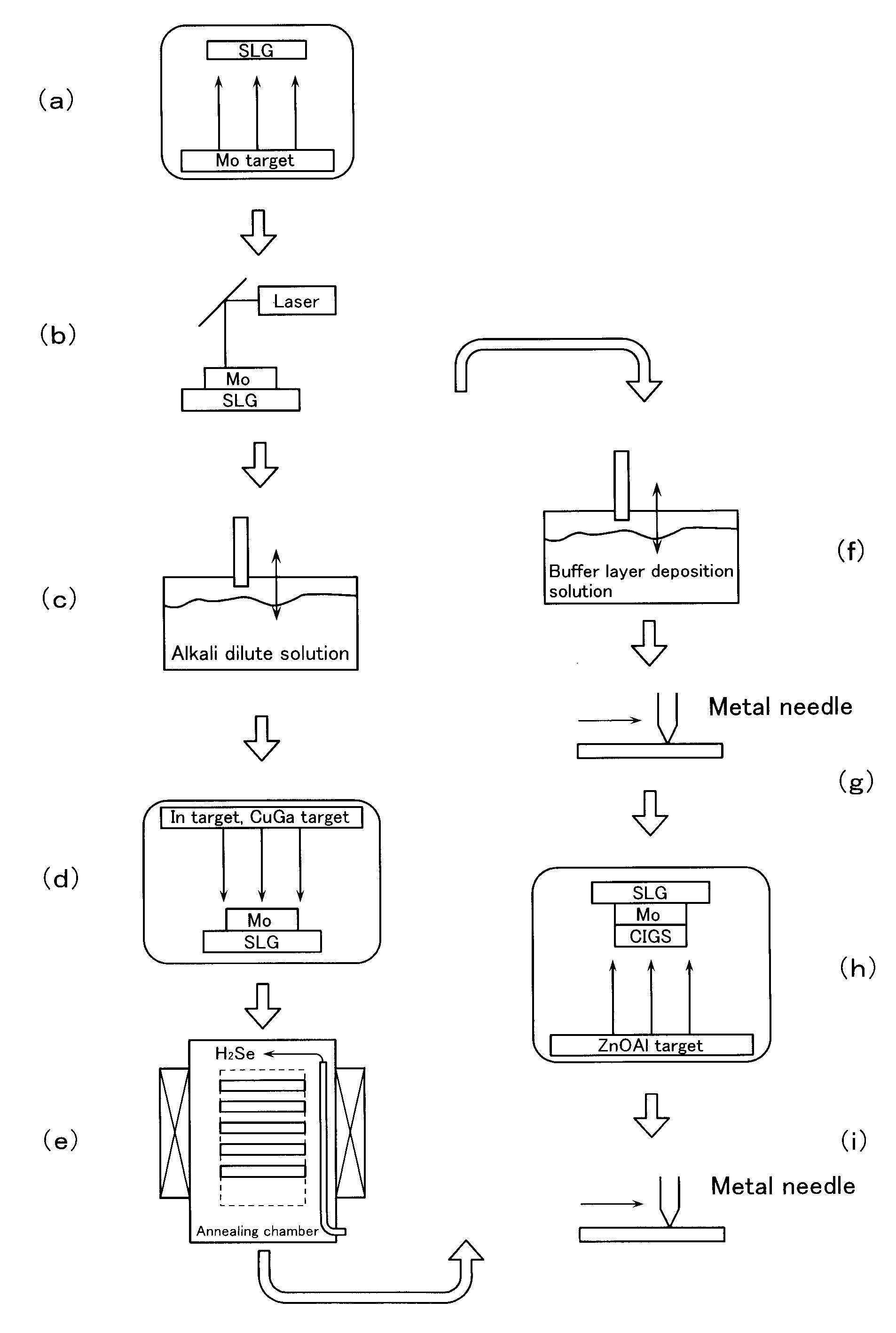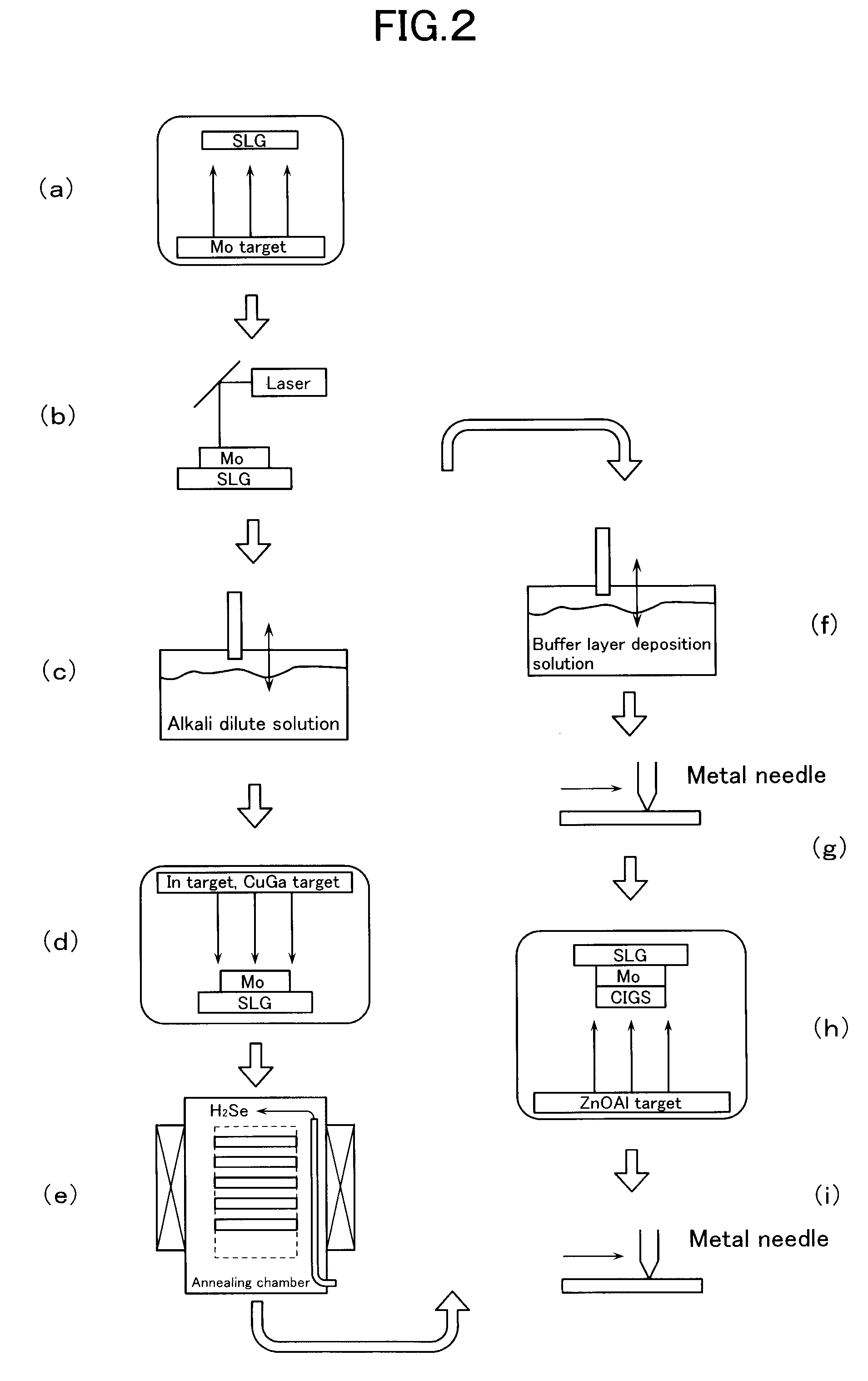Method for Manufacturing Chalcopyrite Thin-Film Solar Cell
a technology of chalcopyrite and thin film, which is applied in the direction of final product manufacturing, sustainable manufacturing/processing, pv power plants, etc., can solve the problems of slight adhesion unevenness of alkali-metal-containing aqueous solution to the electrode layer, stain spots on the surface, and decrease in adhesion between the two layers, so as to improve the photoelectric conversion efficiency of the solar cell and improve the external appearance.
- Summary
- Abstract
- Description
- Claims
- Application Information
AI Technical Summary
Benefits of technology
Problems solved by technology
Method used
Image
Examples
example 1
[0077]Using the inline sputter deposition apparatus illustrated in FIG. 4, a layered precursor consisting of an In metal layer and a Cu—Ga alloy layer was formed on an SLG substrate. Next, the SLG substrate on which the precursor had been deposited was dipped into a 0.8% by weight aqueous solution obtained by dissolving sodium tetraborate decahydrate in pure water, and the attached aqueous solution was then dried by a spin-drying method. After this, a selenization treatment was carried out in accordance with the temperature profile illustrated in FIG. 6 using the heat-treatment apparatus illustrated in FIG. 5.
[0078]Onto the thus formed light absorbing layer, a buffer layer and a conductive transparent electrode layer were deposited in that order, to thereby fabricate a thin-film solar cell. This thin-film solar cell had a stable film internal structure, and exhibited an external appearance free from stain spots. Measurement of the photoelectric conversion efficiency for 8 thin-film ...
examples 2 and 3
[0079]A thin-film solar cell was fabricated under the same conditions as in Example 1, except that the concentration of sodium tetraborate was changed to 1.6% by weight and 2.4% by weight, respectively. These thin-film solar cells had a stable film internal structure, and exhibited an external appearance free from stain spots. Measurement of the respective photoelectric conversion efficiencies for 8 thin-film solar cells fabricated under the same conditions gave, as illustrated in FIG. 8, a photoelectric conversion efficiency of 10.66% and 11.05%.
example 4
[0084]A thin-film solar cell article was fabricated under the same conditions as in Example 1, except that the substrate was changed to a low-alkali glass, such as white sheet glass. At this time, by making various changes to the concentration of sodium tetraborate forming the alkali layer, high respective photoelectric conversion efficiency was exhibited when the concentration was from 3.2 to 4.3% by weight.
[0085]Since the substrate material was a low-alkali glass, the alkali component supplied from diffusion into the light absorbing layer from the substrate was insufficient. However, such a high photoelectric conversion efficiency was attained since the highly concentrated aqueous sodium tetraborate supplemented it.
[0086]Consequently, photoelectric conversion efficiency can be improved comparatively easily by appropriately varying the concentration of an alkali-metal solution, which forms the alkali layer, depending on the substrate material, which may be alkali-containing glass, ...
PUM
| Property | Measurement | Unit |
|---|---|---|
| temperature | aaaaa | aaaaa |
| diameter | aaaaa | aaaaa |
| pressure | aaaaa | aaaaa |
Abstract
Description
Claims
Application Information
 Login to View More
Login to View More - R&D
- Intellectual Property
- Life Sciences
- Materials
- Tech Scout
- Unparalleled Data Quality
- Higher Quality Content
- 60% Fewer Hallucinations
Browse by: Latest US Patents, China's latest patents, Technical Efficacy Thesaurus, Application Domain, Technology Topic, Popular Technical Reports.
© 2025 PatSnap. All rights reserved.Legal|Privacy policy|Modern Slavery Act Transparency Statement|Sitemap|About US| Contact US: help@patsnap.com



